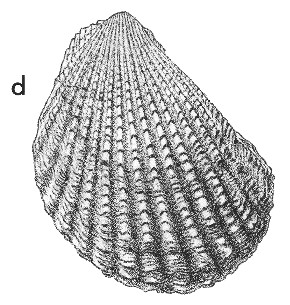
Revised descriptions of New Zealand Cenozoic Mollusca from Beu and Maxwell (1990)

 | Revised descriptions of New Zealand Cenozoic Mollusca from Beu and Maxwell (1990) | 
|
  (Pl. 33d): GS2589, Q21/f6491, east of mouth of Waingongoro River, South Taranaki, Waipipian (GNS) (a specimen with unusually wide radial costae). |
Beu & Maxwell (1990): Chapter 14; p. 280; pl. 33 d.
Synonymy: Lima waipipiensis Marshall & Murdoch 1919, p. 256
Classification: Limidae
Description: Moderately large for genus (70-78 mm high), narrow (length 0.6-0.7 height); small but obvious anterior and posterior ears have strongly descending dorsal margins but parallel, vertical anterior and posterior margins; disc extended very strongly obliquely anteriorly, anterior margin strongly concave. Sculpture of 14 to 17 prominent, narrow, widely spaced radial costae with narrow crests and strongly concave interspaces (so rib section is triangular in most specimens), bearing ventrally hollow, scale-like nodules at frequent intervals; anterior area and ear with 3-4 very narrow costae and with more prominent growth ridges than central area; posterior ear with 1-2 narrow, nodulous costae on a few specimens, but only growth ridges on most. Antimarginal microsculpture between main radial costae very fine. Hinge area tall, wide, flat, with wide, shallow ligamental pit in centre; hinge plate on each side, below ears, triangular and bearing 1 or 2 very small, obscure teeth on each side. Adductor scar large, subcircular, very weakly impressed.
Comparison: Modern Lima species live byssally attached in low-sedimentation environments on the shelf, and presumably L. waipipiensis lived in the same habitat. The few, widely spaced, narrow costae of triangular section and the well developed posterior ear distinguish this species group from the L. colorata-L. zealandica group (see L. colorata, Pl. 18 e,h), but it is difficult, if not impossible, to distinguish L. waipipiensis from L. robini (Campbell Island, Opoitian) and L. becki (Te Waewae Bay, Southland, Kapitean). L. vasis (Flowerpot Harbour, Pitt Island, Waipipian) was based on a very incomplete and poorly preserved specimen that superficially resembles L. waipipiensis but has 22 radial costae. A much better-preserved specimen from another Waipipian locality on Pitt Island (Motutapu Point) indicates relationship to L. colorata rather than to L. waipipiensis (see Pl. 18 e, h), and further recollections show that two Lima species (apparently L. waipipiensis and L. colorata) occur in Whenuataru Tuff. A specimen collected recently as a mould in a large block of Onoua Limestone (apparently a clast from the Pliocene Rangiauria Breccia) on the beach on Mangare Island seems to be L. waipipiensis, and is much larger than other specimens seen, 120 mm high and 108 mm long.
Distribution: Kapitean?; Opoitian-Waipipian; Waipipi Shellbeds, Waverley Beach, west of Wanganui, Waipipian (type); Waihi Beach, Hawera, Waipipian; moderately common. Similar specimens (but of how many species is unclear) occur uncommonly in latest Miocene and early-mid Pliocene throughout New Zealand, mostly in hard-ground, current-swept facies such as limestone.
Cite this publication as: "A.G. Beu and J.I. Raine (2009). Revised
descriptions of New Zealand Cenozoic Mollusca from Beu and Maxwell (1990). GNS
Science miscellaneous series no. 27."
© GNS Science, 2009
ISBN
978-0-478-19705-1
ISSN 1177-2441
(Included with a PDF facsimile file
copy of New Zealand Geological Survey Paleontological Bulletin 58 in CD version
from: Publications Officer, GNS Science, P.O. Box 30368 Lower Hutt, New
Zealand)